
Donation After Circulatory Death (DCD)
Definition:
- DCD refers to the donation of organs from a donor who has been declared dead based on the irreversible cessation of circulatory and respiratory functions.
Types of DCD:
- Controlled DCD: Involves donors who have had life-sustaining treatment withdrawn in a controlled setting, typically in an intensive care unit (ICU).
- Uncontrolled DCD: Involves donors who experience unexpected cardiac arrest and cannot be resuscitated.
Process:
- Decision to Withdraw Treatment: A decision is made to withdraw life-sustaining treatment based on the donor’s prognosis and in consultation with their family.
- Consent: Obtain consent for organ donation from the donor’s family.
- Withdrawal of Treatment: Life-sustaining treatment is withdrawn, and the donor is monitored for cessation of circulatory and respiratory functions.
- Circulatory Death Declaration: Death is declared after circulatory arrest is confirmed, typically after 5 minutes of no cardiac output.
- Organ Retrieval: After death is confirmed, organs are rapidly cooled and preserved for transplantation.
Challenges:
- Organ Viability: Organs from DCD donors may be more susceptible to warm ischemia (lack of blood flow and oxygen), which can affect their viability and function after transplantation.
- Timing: The timing of organ retrieval is critical to minimise warm ischemia time.
Donation After Brain Death (DBD)
Definition:
- DBD refers to the donation of organs from a donor who has been declared dead based on the irreversible cessation of all brain functions, including the brain stem.
Process:
- Diagnosis of Brain Death: Brain death is diagnosed based on strict clinical criteria, including the absence of brain stem reflexes and the inability to breathe independently.
- Consent: Obtain consent for organ donation from the donor’s family.
- Maintaining Donor Stability: The donor is maintained on mechanical ventilation and haemodynamic support to preserve organ function until retrieval.
- Organ Retrieval: Organs are retrieved in a controlled surgical environment while the donor’s circulation is maintained.
Advantages:
- Organ Viability: Organs from DBD donors are generally in better condition due to continuous perfusion (blood flow and oxygen) until the time of retrieval.
- Wider Range of Organs: DBD allows for the donation of a wider range of organs, including the heart, lungs, liver, kidneys, pancreas, and intestines.
Challenges:
- Consent Process: Ensuring that the family understands brain death and consents to organ donation can be complex and emotionally challenging.
Comparison of DCD and DBD
| Aspect | DCD | DBD |
|---|---|---|
| Definition | Donation after circulatory death | Donation after brain death |
| Criteria for Death | Irreversible cessation of circulatory and respiratory functions | Irreversible cessation of all brain functions, including the brain stem |
| Organ Viability | Higher risk of warm ischemia | Generally better due to continuous perfusion |
| Organs Typically Donated | Kidneys, liver, pancreas, lungs | Heart, lungs, liver, kidneys, pancreas, intestines |
| Timing | Rapid retrieval required post-death | More controlled timing with continuous support |
| Consent | Family consent after circulatory death | Family consent after brain death diagnosis |
Conclusion
Both DCD and DBD are vital pathways for organ donation, each with its unique processes, advantages, and challenges. DBD typically allows for a broader range of organs to be donated and generally maintains better organ viability due to continuous perfusion. However, DCD remains a crucial source of organs, especially in situations where brain death criteria are not met but organ donation is still possible. Ensuring proper consent, maintaining donor stability, and optimising organ retrieval techniques are essential for both DCD and DBD to maximise the benefits of organ transplantation.
